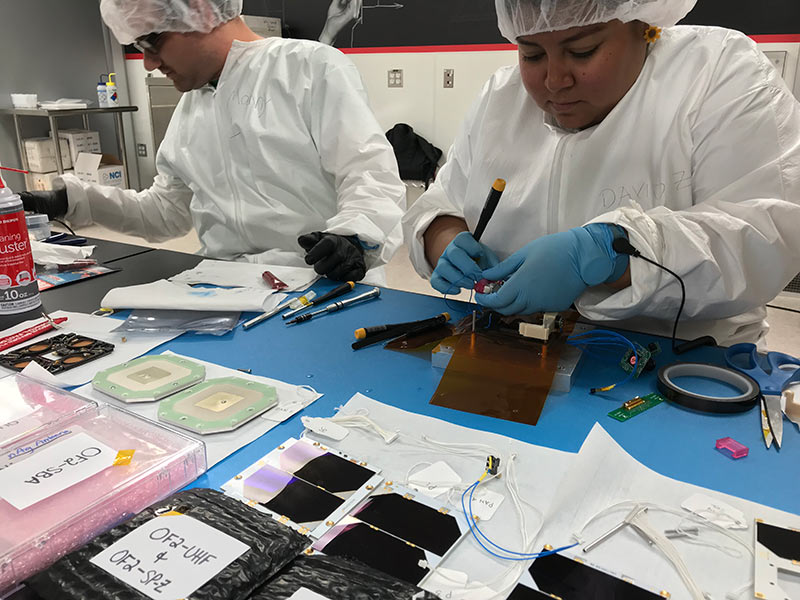UTEP Successfully Communicates With Satellite to Cap Monumental Project
Last Updated on February 10, 2020 at 12:00 AM
Originally published February 10, 2020
By UC Staff
UTEP Communications
The NASA MIRO Center for Space Exploration and Technology Research (cSETR) at The University of Texas at El Paso has successfully communicated with its Orbital Factory-2 (OF-2) satellite project, a significant feat that highlights UTEP’s position as a national leader in technological research and its implementation.

The Orbital Factory-2, which was designed and developed in collaboration with Lockheed Martin Space and NASA to demonstrate on-orbit repair of solar cells using 3D printing technology, pinged a reply to a cSETR research team at 8:51 p.m. Friday, Jan. 31, 2020, while in orbit 295 miles above the Earth.
The achievement is a momentous example of the promise UTEP holds for innovation, 21st century workforce development and student research opportunities.
Joel Quintana, Ph.D., research assistant professor of mechanical engineering and a UTEP alumnus, said 25 students from various engineering disciplines worked on the OF-2 project throughout the course of two years. He was with a group of those students at a cSETR research space provided by the City of El Paso near the UTEP campus as they waited on notification from OF-2.
“Seeing their excitement when the first ping came in when they were able to communicate with the satellite as it orbited over El Paso was priceless,” Quintana said. “They leave this program knowing how to design, build and test spacecraft, making them really high in demand and industry experts.”
With this milestone reached, cSETR will now set off on a set of new initiatives including the development of spacecraft capabilities for on-orbit manufacturing, and planetary and lunar exploration. The center will conduct this work concurrently with its primary mission of training El Paso talent and cultivating a space technology workforce.
The success of OF-2 has been an incredible development, said Ahsan Choudhuri, Ph.D., associate vice president for strategic initiatives and cSETR’s founder and director. He added that support from space exploration luminaries played a vital role in the accomplishment.
“This is a very complex project,” Choudhuri said. “It’s important that we have industry partners such as NASA and Lockheed Martin Space who build satellites and are willing to work with our students and mentor them on how to navigate some of the highly technical challenges.”
Amelia Greig, Ph.D., assistant professor of mechanical engineering, joined the cSETR research program in fall 2019. She provides expertise in micro-propulsion and micro-satellites, and a teaching background in spacecraft propulsion and the space environment. Greig previously served as assistant professor in the Aerospace Engineering Department at California Polytechnic State University (Cal Poly) in San Luis Obispo.
“It takes complex, real-world engineering to put something into orbit. Being able to communicate with the satellite was a major breakthrough,” Greig said. “Students working in the program come from different disciplines and leave with great opportunities. Students who can design, build and test spacecraft become in high demand.”
Eduardo Macias Zugasti, a graduate research assistant who expects to receive a master’s degree in computer engineering in spring 2020, said cSETR has provided a great experience learning about satellites, onboard computers, electric power systems, real-time operating systems and payload design.
“I learned how to work in a team,” Macias Zugasti said. “It is not only about your job to be done, but the entire team’s, because all of the members are looking for the same objective. I have participated in several presentations that have helped me to be more confident when I am speaking. Moreover, I have had the opportunity to present my work to people from different companies such as United Launch Alliance and Lockheed Martin.”
James Holt, an aerospace engineer at NASA’s Marshall Space Flight Center who received his bachelor’s and master’s degrees from UTEP, was the first student to work on OF-2 as a co-author on the proposal. He was closely involved with its initial design, concept of operations and hardware selection during his time at cSETR from 2016 to 2019. His research focused mostly on trajectory design and mission analysis. Holt said he was elated to see OF-2 in orbit and sending beacon signals to earth. He joined the Marshall Center in 2018, where he works with the mission analysis and design team on trajectory design and mission analysis. Holt said the skills and experience he developed at cSETR directly helped his career.
“My favorite memory of cSETR was when I first began work on Orbital Factory-2,” Holt said. “We submitted a proposal to United Launch Alliance (ULA) for a launch slot aboard an Atlas V rocket. One day, I received a phone call from ULA informing me that the CEO, Tory Bruno, wanted to schedule a time to speak with me. Mr. Bruno personally informed us that not only had we been awarded a launch opportunity, but that we had won first place. We worked hard in the following months to kick off the project and finalize our preliminary design. Later, we also had the opportunity to travel to Austin, where the Texas Legislature recognized our accomplishment. ULA, Lockheed Martin and NASA have continued to provide excellent mentoring and feedback for the students working on Orbital Factory-2, which helped overcome some of the design obstacles that we encountered.”
Choudhuri said NASA’s contributions have been invaluable and have helped cSETR place 400 engineering graduates and students into the workforce.
“We hope to continue this strong collaboration with NASA as their investment helps support these programs and infrastructure,” Choudhuri said.
To learn more about cSETR, go to utep.edu/csetr.